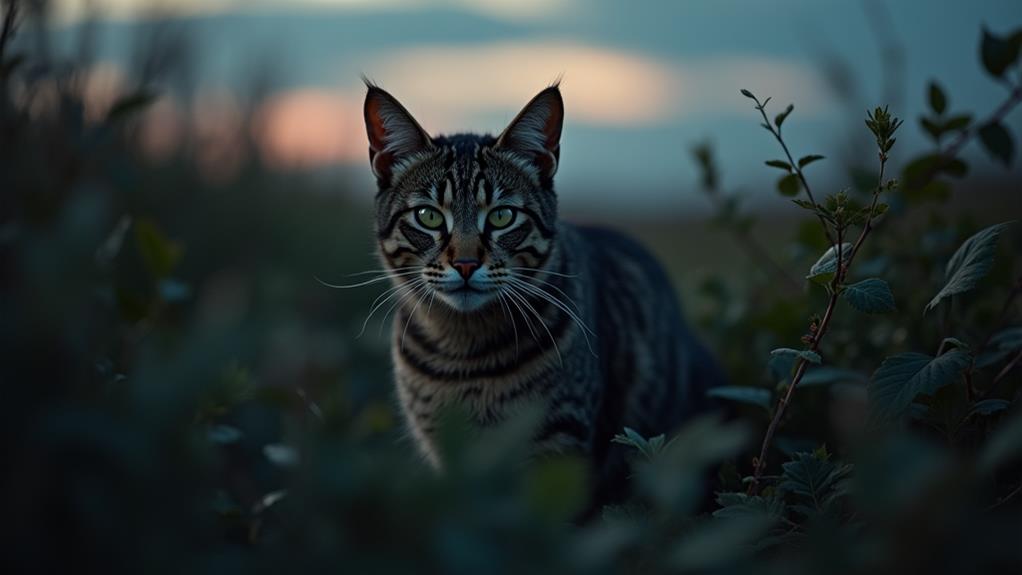Do Feral Cat Families Stay Together? Exploring Their Social Structure
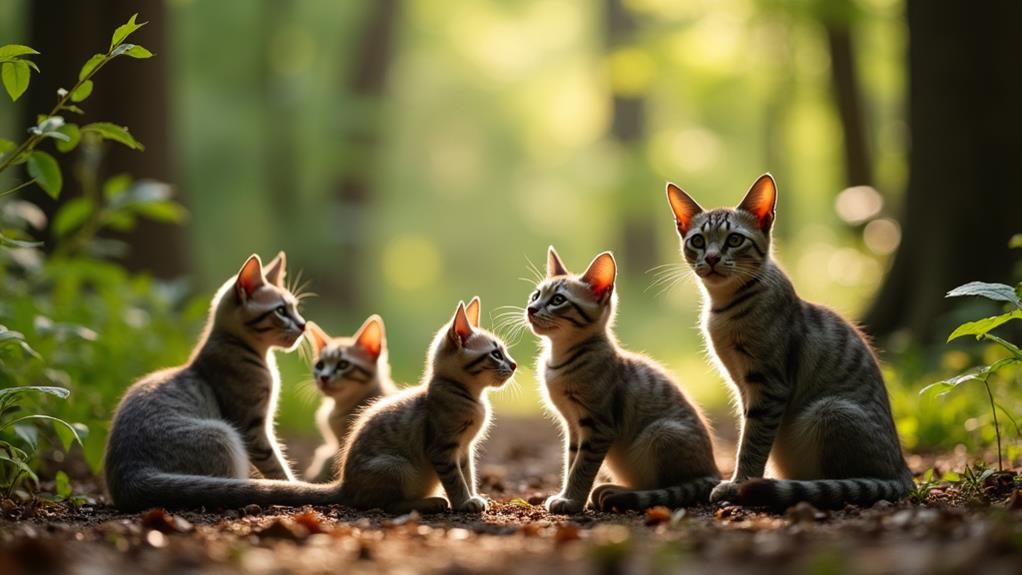
Feral cat families do tend to stay together, especially matrilineal groups of related females and their kittens. These colonies form tight social bonds through grooming and close sleeping arrangements, which improve their survival. Unlike many other animal groups, feral cat colonies don't have a strict hierarchy, allowing for cooperation and flexible social roles. Males typically maintain territories on the periphery, focusing on mating opportunities and resource access. Food availability plays a vital role; richer areas see larger colonies with stronger social ties. Understanding these dynamics reveals fascinating insights into their complex social life that's worth digging into.
Understanding Feral Cat Colonies
Feral cat colonies are fascinating social structures primarily made up of related females and their kittens, working together to share resources. These matrilinear colonies thrive where food sources are abundant, allowing feral cats to form strong social bonds. You'll notice that the females and their offspring engage in affiliative behaviors like grooming and sleeping closely together, which strengthens these bonds and guarantees the colony's cohesion.
Feral cats within these colonies don't follow a strict hierarchy, so interactions are fluid, allowing them to cooperate flexibly as needed. This lack of hierarchy helps in maintaining the social structure, where every member can contribute and benefit from the shared resources. The size of a colony often hinges on the availability of food sources. In areas rich with resources, you'll find larger colonies, while in scarce environments, feral cats might live solitarily.
Males, meanwhile, tend to stay on the periphery of these colonies. Although not part of the core social group, they maintain larger territories that overlap with female colonies. This dynamic allows the females to focus on rearing their kittens and maintaining their close-knit social bonds within the colony.
Territorial Behavior in Cats
You'll find that territorial behavior plays a significant role in the lives of feral cats, ensuring safety and minimizing conflict. Each feral cat establishes a personal territory, marked by scent from facial glands, urine, and feces. This marking helps secure their space and reduces the likelihood of conflict with other cats. The size of these territories can vary greatly. Typically, female feral cats have smaller territories, often dictated by food availability, whereas dominant males may control territories up to three times larger.
In urban settings, a female cat's home range might be as small as 0.27 hectares. Conversely, in rural areas, their territory can stretch up to 170 hectares. When an unfamiliar cat encroaches on established territories, feral cats often resort to aggressive behavior, like hissing and growling, to defend their area. Such interactions are vital to their social structure, as territorial divisions help reduce conflicts.
Interestingly, feral cats generally prefer avoiding direct confrontations. They often coexist within overlapping home ranges without direct social interactions, maintaining a delicate balance that supports their survival and social structure. This territorial behavior highlights the significance of boundaries in their complex social lives.
Female-Centric Social Structures
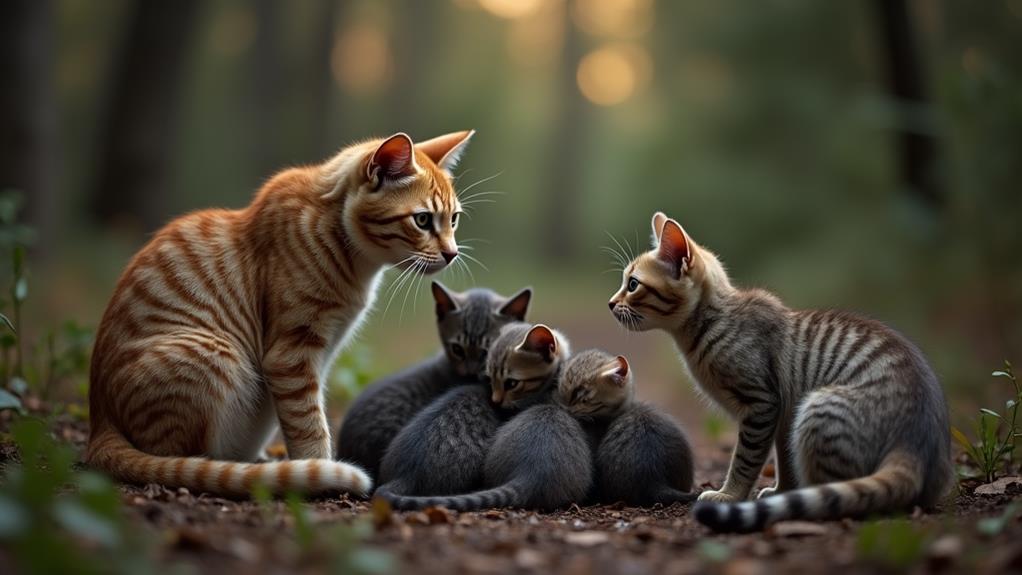
While territorial behavior defines individual spaces, the heart of feral cat social life beats in female-centric colonies. These colonies are largely matrilineal, with female cats forming the core of the group. They create strong social bonds through affiliative relationships, engaging in grooming and sleeping close to each other. This closeness isn't just about companionship; it boosts their collective survival. By staying tight-knit, they manage resources more effectively, ensuring everyone gets enough food and protection.
In feral cat colonies, cooperative rearing is a hallmark of their social structure. Female cats, or queens, often assist one another in nursing and protecting kittens. This teamwork isn't limited to related females; unrelated queens also join forces, showcasing their commitment to enhancing offspring survival rates. Through such collaboration, kittens benefit from shared caregiving, which elevates their chances of thriving in the wild.
The size of these colonies can vary based on food availability. Larger groups typically form where resources are plentiful, allowing for more extensive social networks among the female cats. Despite any males that might linger on the outskirts, it's the females who drive the colony's success, maintaining its nurturing essence.
Role of Male Cats
In the world of feral cat colonies, male cats often linger on the periphery, maintaining territories that can be considerably larger than those of females. These territories sometimes overlap with multiple female colonies, giving dominant males an advantage regarding mating opportunities. Dominant males assert control over expansive areas, while female groups often align within these larger territories, benefiting from the protection and resources a dominant male may provide.
Aggression is a common trait among male cats, especially as they patrol their domains. This behavior intensifies during mating seasons when competition for estrous females heightens. However, not all interactions are aggressive. Despite the competitive nature of male cats, non-aggressive interactions, such as grooming, can occur. This reflects a more complex social dynamic where familiar male and female cats can engage in positive social behaviors.
Male kittens, as they mature, may face aggression from established males, often being excluded from territories. This exclusion is part of the social dynamics that prevent the younger males from challenging the status quo. Understanding these territorial behaviors and social interactions offers insight into the broader social structure of feral cat communities.
Aggression and Conflict
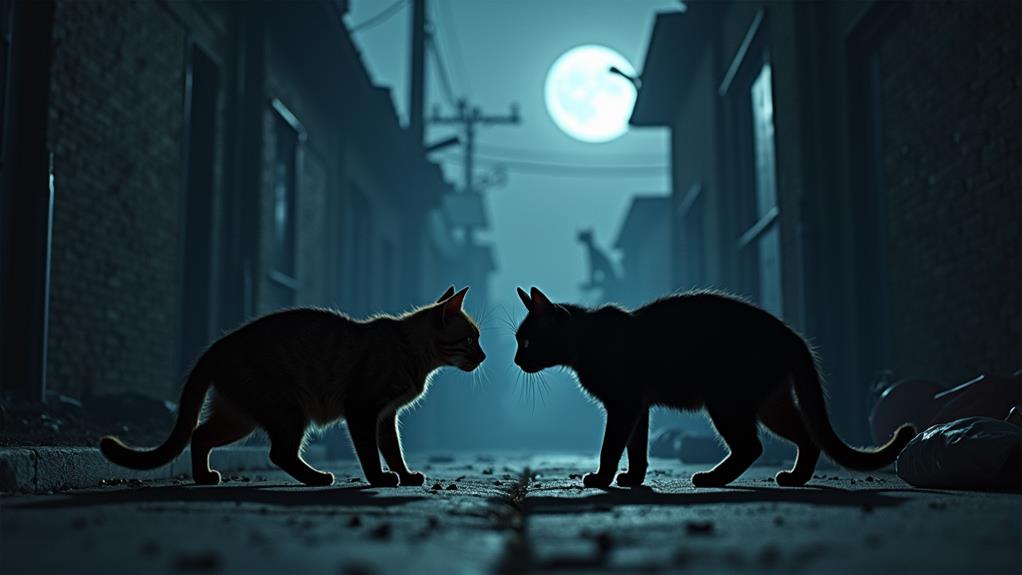
Aggression and conflict are integral to the social dynamics of feral cat colonies. Within female feral cat colonies, aggression tends to be minimal because these groups are often composed of related individuals who are familiar with each other. This familiarity fosters a cooperative environment, reducing the need for aggressive social behaviors. However, things change when male kittens reach sexual maturity. They're excluded from their maternal groups, leading to increased conflicts as they assert themselves, seeking territory and resources.
Male cats play a significant role in the aggression seen in feral cat colonies. They patrol their territories diligently, often engaging in aggressive interactions, particularly with females during mating seasons. Competition peaks during these times, as the drive to secure mates and resources intensifies. Studies have shown that 97.5% of aggressive encounters happen near food sources, highlighting the critical role of resources in these conflicts.
The limited ability of feral cats to communicate complex visual signals exacerbates these aggressive encounters. Misunderstandings can easily arise during territorial disputes, often resulting in fights. Consequently, aggression and conflict, while integral, also reflect the ongoing struggle for survival among feral cats.
Socialization Continuum
Socialization in cats isn't a simple yes-or-no status; it's a continuum that ranges from fully socialized cats who thrive on human interaction to feral cats that shy away from people. On this socialization continuum, you'll find different degrees of social behavior among cats. Community cats often form small groups, relying on each other for survival but maintaining cautious social relationships with humans. Feral cats, in particular, are usually on the far end of this spectrum, often avoiding human contact altogether.
Kittens are most receptive to socialization between 2 to 14 weeks old. During this significant period, positive experiences can greatly influence their future social behavior. However, a cat's position on the socialization continuum isn't fixed. Individual experiences, interactions with other cats, and human contact can shift a cat's socialization level over time. The Touch Barrier concept highlights this: socialized cats are generally more comfortable with human touch than their feral counterparts.
Factors like maturity, past experiences, and environmental stressors add complexity to evaluating a cat's socialization. Understanding a cat's personality and previous social relationships is vital for developing effective strategies to help them move along the continuum.
Affiliative Behaviors
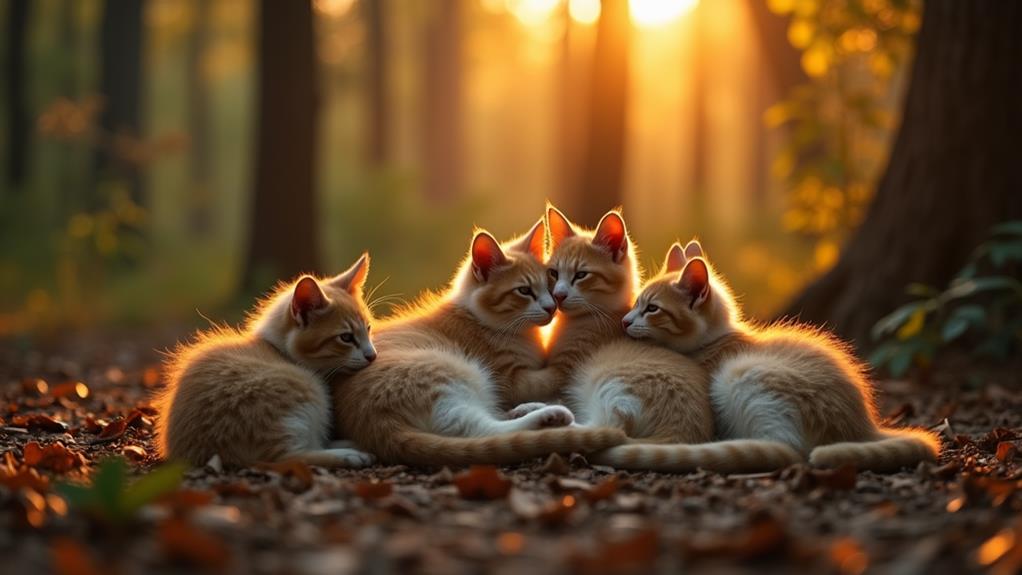
Understanding a cat's socialization is only part of the picture; observing their affiliative behaviors reveals how they connect within their social structures. In feral cat colonies, these behaviors, such as grooming and allorubbing, play an essential role in strengthening social bonds. Grooming, in particular, is a significant activity, accounting for 53.4% of social interactions at Church Farm. This behavior fosters familiarity and trust among colony members, laying the groundwork for strong, cooperative relationships.
Familiarity among these cats improves caregiving behaviors, especially among mothers. They often cooperate in rearing kittens, sharing duties like grooming and feeding. This cooperation guarantees that kittens receive the care they need, increasing their chances of survival. Moreover, cats tend to stay within close proximity, often within 10 meters of one another, favoring interaction with familiar individuals. In fact, 43.1% of observations highlight this preference for familiar company.
Kinship and familiarity in feral cat colonies also lead to reduced aggression and increased cooperation. These affiliative behaviors not only strengthen social bonds but also contribute to the complete success and cohesion of the colony. By understanding these dynamics, you gain insight into the complex social world of feral cats.
Impact of Food Availability
Food availability plays an important role in shaping the dynamics of feral cat colonies. When food is abundant, you'll find larger colonies, as the generous resources support more cats. In such environments, social relationships flourish, especially among females in matrilinear colonies. These cooperative bonds help improve the survival rates of offspring, ensuring the continuity of the group. However, when food is scarce, the social structure shifts dramatically. Feral cats might prioritize their own survival over maintaining social ties, often leading to more solitary lifestyles.
Aggression becomes a common sight when resources are limited. In fact, 97.5% of aggressive encounters among feral cats occur near food sources. This highlights the intense competition for these essential resources. You might notice that feral cat population densities can vary markedly depending on the availability of food. For instance, rural farms might host as few as 6 cats per square kilometer, while food-rich locations like Ainoshima can see densities soar to 2,350 cats per square kilometer.
Understanding the impact of food availability offers insight into the complex social structures of feral cat colonies and underscores the significant role resources play in their lives.
Human-Cat Interactions
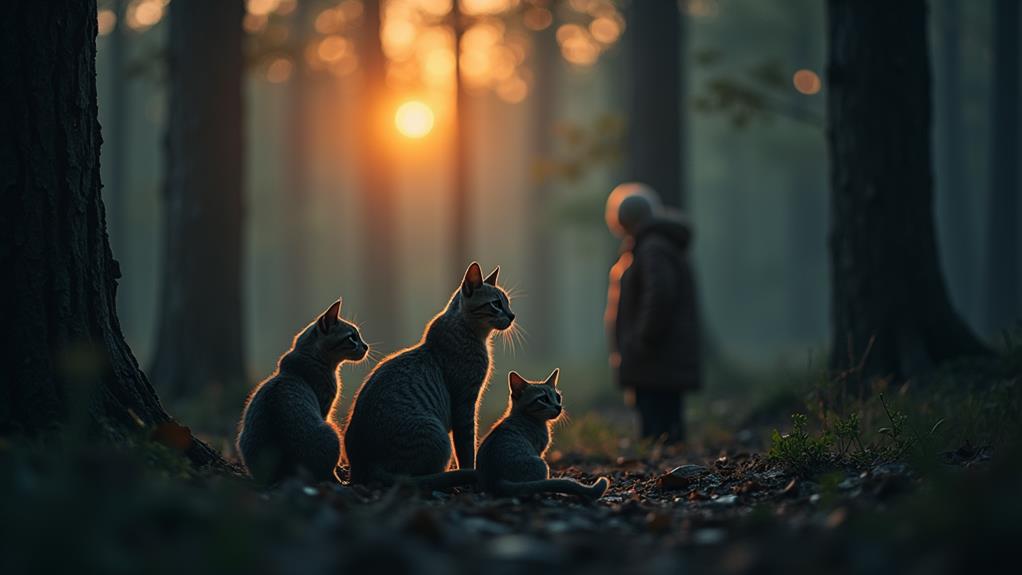
Interactions between humans and feral cats are as diverse as the cats themselves. You'll find that some feral cats are surprisingly social, allowing petting and play, especially in culturally significant places like Japan. These positive interactions can encourage socialization, making feral cats more comfortable in human spaces. However, negative experiences can have the opposite effect, leading to fear and avoidance. Community cats, a mix of feral and stray individuals, often depend on humans for resources such as food, forming a unique bond with local communities.
- Human involvement shapes social dynamics: Through supplemental feeding, humans can influence the social structures within feral cat colonies.
- Positive interactions foster trust: Cats that encounter kindness may become more sociable, improving their quality of life.
- Welfare strategies are vital: Understanding these interactions helps in crafting effective welfare strategies aimed at enhancing the lives of these cats.
Managing the relationship between community cats and humans is significant. By providing resources and fostering positive interactions, you can help improve the welfare of feral cats. It's imperative to recognize how your actions and those of your community can impact these cats, affecting their behavior and social organization.
Ecological Implications
While human interactions can shape the lives of feral cats, their presence also brings considerable ecological implications. Feral cat colonies often form where food is abundant, leading to high population densities. For example, on Ainoshima, you can find a staggering 2350 feral cats per square kilometer, which strains local ecosystems. This concentration of cats can disrupt the balance of native species, as they hunt and greatly reduce populations of small mammals and birds, impacting local biodiversity.
The ecological impacts of feral cats extend beyond predation. These colonies can spread diseases among wildlife and domestic cats, creating further ecological risks. This poses challenges for wildlife management, as you need to take into account both the health of these animals and the integrity of the ecosystems they inhabit. Understanding the social groups and dynamics of these colonies is crucial for implementing effective management strategies.
To mitigate these ecological impacts, wildlife management must take into account the social structure of feral cat colonies. By addressing the root causes of high population density and focusing on sustainable solutions, you can help preserve biodiversity and reduce the adverse effects of feral cats on local ecosystems.

